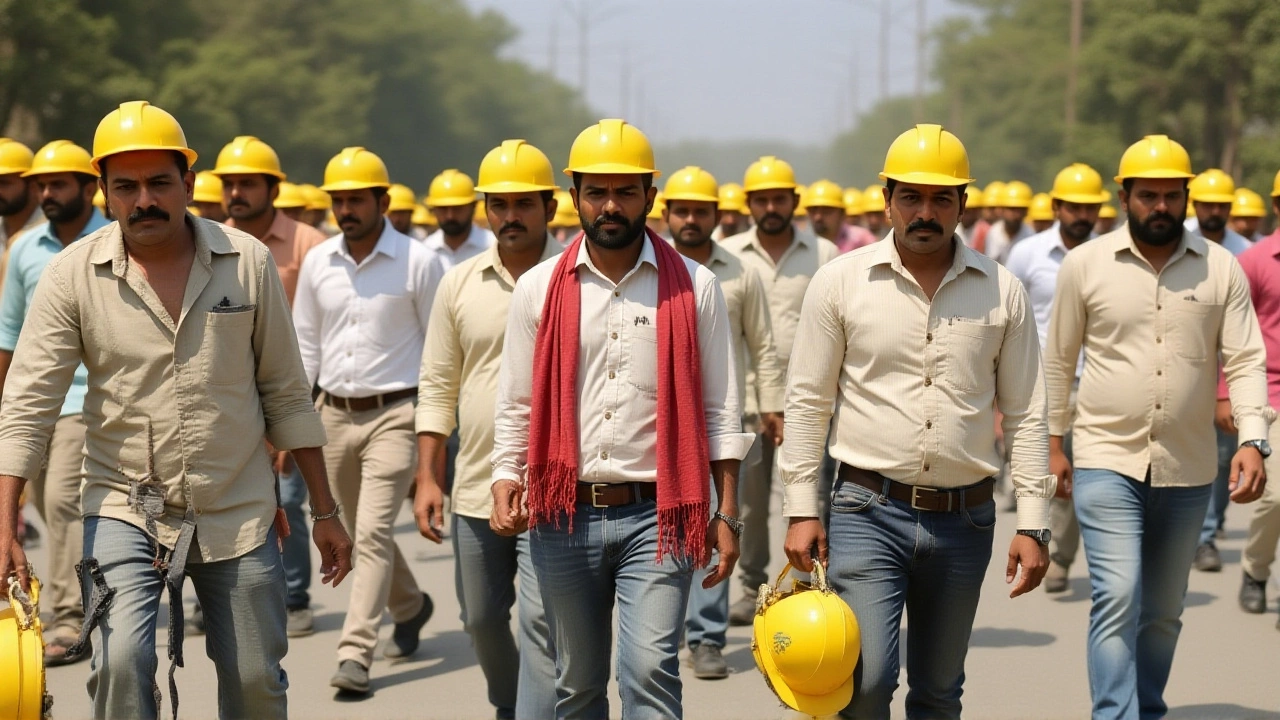On November 21, 2025, at 12:00 AM UTC+5:30, India Ministry of Labour and Employment rolled out four sweeping Labour Codes, ending decades of fragmented labor laws and reshaping employment across one of the world’s largest workforces. The move affects an estimated 475 million workers — formal and informal — and marks the most significant overhaul of India’s labor framework since independence. What makes this different isn’t just the scale, but the quiet revolution in how workers are treated: gig workers now get social security, overtime must be voluntary and paid double, and companies with 100 to 299 employees no longer need government approval to lay people off. Labour codes aren’t just bureaucratic jargon — they’re changing paychecks, job security, and daily life for millions.
From 100 to 300: The Retrenchment Threshold Shift
For years, any factory or firm with more than 100 workers needed state permission before laying off staff. That rule, rooted in the 1970s, was meant to protect jobs — but it also scared off investment and trapped small businesses in red tape. Now, the Industrial Relations Code (2020) raises that threshold to 300 employees. Companies with 100 to 299 workers can cut staff without bureaucratic hurdles. But there’s a catch: they must pay into a Reskilling Fund — 15 days’ last drawn wages per worker terminated. It’s not a severance package. It’s an investment in retraining. The goal? To soften the blow for displaced workers while giving employers breathing room.
This change hits hardest in mid-sized manufacturing hubs like Coimbatore, Ludhiana, and Tiruppur, where factories hover just below the old 100-worker mark. Now, many can scale up or down without waiting months for government clearance. But labor unions are nervous. "It’s not about approval anymore — it’s about accountability," said Anjali Mehta of the All India Trade Union Congress in a November 23 interview. "If the fund isn’t monitored, it becomes a slush fund for employers."
Universal Wages, Mandatory Letters, and the Gig Economy
Before, minimum wages only applied to "scheduled" industries — leaving out cleaners, delivery riders, domestic helpers, and street vendors. The Code on Wages (2019) changes that. Now, every worker, regardless of sector, is entitled to the National Floor Wage, set by the Centre and non-negotiable by states. Tamil Nadu and Maharashtra have already announced wage hikes to match. Meanwhile, every worker — yes, even the Uber driver or Swiggy delivery person — must receive a written appointment letter detailing pay, duties, and benefits. No more "we’ll pay you when we can."
The Code on Social Security (2020) goes even further. Platform aggregators like Ola, Zomato, and Flipkart must now contribute 1–2% of their annual turnover — capped at 5% of total payments to workers — into a social security fund. That means gig workers get access to health insurance, maternity benefits, and even pension contributions. For the first time, India is treating platform labor as real work — not a side hustle.

Double Overtime, Shorter Leave, and the Salary Trap
Workers now earn double their regular pay for overtime — and only if they agree to it. Forced overtime? Illegal. The limit on weekly hours remains 48, but states can allow more — as long as workers consent. Paid leave eligibility dropped from 240 to 180 days of work per year. That’s a win for seasonal workers and part-timers who previously couldn’t qualify. But here’s the twist: the new rules require basic salary to be at least 50% of the total Cost to Company (CTC). For many, that means a lower take-home pay. Why? Because employer contributions to provident fund, insurance, and other benefits are now tied to basic salary — not total compensation.
"You’re not getting less money overall," explains Dr. Rajiv Kapoor, an economist at the Indian Council for Research on International Economic Relations. "But you’re getting less cash in hand. That’s going to hurt households living paycheck to paycheck."
Fixed-Term Workers, Safety, and the Inspector-Cum-Facilitator
Fixed-term employees — once treated as temporary and disposable — now qualify for gratuity after just one year of service, down from five. That’s huge for contract workers in IT, media, and construction. Mine workers get mandatory annual health checks, safety committees, and recognition of commuting accidents as work-related injuries. Factories now need only one registration, one license, and one return form — replacing 44 separate filings. And here’s the most surprising change: inspectors are now called Inspector-cum-Facilitators. Their job isn’t just to punish violations — it’s to help businesses comply. Think of them as labor advisors, not cops.
The Occupational Safety, Health and Working Conditions (OSHWC) Code (2020) mandates safety committees in firms with 500+ workers. And for the first time, transgender workers are explicitly protected from discrimination in hiring, pay, and promotion. The India Ministry of Labour and Employment has launched a digital portal at labour.gov.in and a helpline to guide employers and workers through the transition — available until December 31, 2025.

What’s Still Unclear?
Implementation remains patchy. While the Centre has set the framework, each state must issue its own rules. As of late November, only 12 of 28 states had notified their rules. In Bihar and Jharkhand, delays are expected into early 2026. Labor groups warn that without strong enforcement, the Reskilling Fund could vanish into bureaucratic limbo. And while gig workers are now covered, many don’t know they’re eligible — and aggregators may skirt compliance.
"The law is progressive," says Priya Desai, a labor rights lawyer in Bengaluru. "But progress without awareness is just paperwork."
Frequently Asked Questions
How does the new retrenchment threshold affect small businesses?
Companies with 100–299 employees no longer need government approval to lay off workers, reducing delays and legal risks. But they must pay 15 days’ wages per terminated worker into the Reskilling Fund. This balances flexibility with worker protection, especially in manufacturing and service sectors where staffing fluctuates seasonally.
Are gig workers really covered under the new codes?
Yes. Aggregators like Ola, Zomato, and Swiggy must contribute 1–2% of annual turnover (capped at 5% of payments to workers) into a Social Security Fund. This covers health insurance, maternity benefits, life and disability cover, and pension — something previously unavailable to platform workers, who now have legal recognition as beneficiaries.
Why is my take-home pay lower even though my CTC increased?
The new rules require basic salary to be at least 50% of CTC. Since employer contributions to PF, gratuity, and insurance are calculated on basic pay, a higher basic salary means more deductions — even if total compensation stays the same. Workers may see lower cash in hand but higher long-term benefits like retirement savings.
What happens if my state hasn’t notified the rules yet?
The central codes are legally enforceable, but states must issue implementation rules by December 31, 2025. Until then, workers in non-notifying states should refer to the central guidelines and use the labour.gov.in portal to report violations. The Ministry is offering technical support to states, but delays could mean uneven enforcement — especially in rural areas.
Do fixed-term workers now get the same benefits as permanent staff?
Yes. Fixed-term employees now qualify for gratuity after one year (down from five), equal pay for equal work, and access to all social security benefits under the Code on Social Security. They’re no longer treated as temporary labor — a major shift that benefits contract workers in IT, media, and retail sectors.
How are transgender workers protected under the new codes?
The Industrial Relations and Social Security Codes explicitly prohibit discrimination based on gender identity. Transgender workers are guaranteed equal pay, safe working conditions, and access to all social security schemes. Employers must also ensure non-discriminatory hiring practices — a landmark inclusion that aligns India with global labor standards on gender equity.








Write a comment